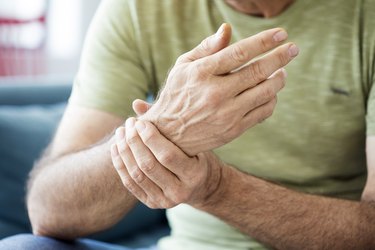
Like the eyes are the window to the soul, your palms can be a window to your underlying health.
Palmar erythema — or red palms — is a common condition that happens when the heels of your palms (and sometimes your fingers) turn red or pink and feel slightly warm.
Video of the Day
Video of the Day
The nerves and muscles in our hands require a rich supply of blood to function. That means any inflammatory process that affects blood flow could result in a color change of the tissues of your palms, says Neil Farnsworth, MD, a board-certified dermatologist with Westlake Dermatology in Houston.
Most times, red palms are harmless and will ease up on their own. But they can sometimes be a sign of a deeper medical issue. Here's a look at some of the most common culprits along with what you can do to find relief.
1. They Run in Your Family
Like hair or eye color, a reddish tint to your palms can simply run in your family.
"They're a common hereditary trait," Dr. Farnsworth says. "So you're probably not noticing them unless someone points them out."
You may also notice your palms get redder when you're flustered, when they're warm or when you keep your hands in the same position for a long time.
Fix it: Hereditary palmar erythema isn't typically a problem, and there's no specific treatment for it, according to DermNet New Zealand Trust. But if your palms seem to look redder than usual and you're concerned, there's no harm in bringing it up with your doctor or dermatologist.
2. Your Hands Are Irritated
External factors (think: washing your hands too often, using heavily scented moisturizers or prolonged contact with irritating chemicals) can also make your palms red, according to Dr. Farnsworth.
"[These factors] can strip and compromise the normal lipid barrier of the skin, resulting in irritation, redness, painful cracking and fine, dry scale," he says.
Fix it: Try to avoid products or substances that make your hands red or uncomfortable, Dr. Farnsworth says. "Wear protective gloves when handling chemicals like bleach or cleaning products, use fragrance-free body wash and moisturize with a fragrance-free product after washing your hands," he adds.
3. You Have Eczema
When you have eczema, you may experience all-over body dryness and irritation. This means you may experience itchy palms, which can become red as a result, per the National Eczema Society.
You may also notice blisters on your palms and sides of your fingers, or that your palms have a wrinkled appearance, Dr. Farnsworth says.
Fix it: Managing eczema typically comes down to reducing your exposure to irritating triggers (like harsh cleaning products, fragrances, heat or cold, dry air). Try moisturizing regularly with a doctor-approved eczema cream or ointment to help maintain your skin's protective barrier, per the Mayo Clinic. You could also try some natural remedies for eczema, like coconut oil.
4. You're Pregnant
Pregnancy can cause all sorts of strange symptoms, red palms among them. The culprit is your naturally increased estrogen levels, Dr. Farnsworth says, which can increase blood flow to the palms. For this reason, you might also feel a "pins-and-needles" tingling in your hands.
If your palms are also itchy, though, that may be a sign of cholestasis, per the Mayo Clinic. This is a potentially dangerous liver condition that can crop up later in pregnancy and typically causes intense itching on the hands and feet.
Fix it: Palmar erythema during pregnancy isn't harmful, but the tingling feeling can get annoying. Applying a fragrance-free hand lotion or moisturizer can help, Dr. Farnsworth says. And hang in there: The problem should ease up after you give birth.
If your red palms come with itching, though, tell your health care provider right away. Cholestasis of pregnancy can lead to complications including preterm and stillbirth.
5. You Have Palmoplantar Psoriasis
Palmoplantar psoriasis is a form of psoriasis that affects the palms of your hands and soles of your feet, according to the National Psoriasis Foundation.
With this type, your palms may be marked by thick, reddish scales or pustules — which can be painful or itchy. You might also notice your fingernails have red or yellow spots or a pitted appearance, Dr. Farnsworth says.
Other common places you can experience plaque psoriasis include the scalp, abdomen, elbows and knees, per the Mayo Clinic.
Fix it: Psoriasis — on your palms or elsewhere — typically requires medical treatment. Your dermatologist may start by recommending topical corticosteroids to reduce scaling, or recommend lifestyle changes to help psoriasis. If that doesn't help, they may also prescribe light therapy or oral medications like methotrexate or cyclosporine, according to the American Academy of Dermatology Association.
6. You're a Smoker
Experts don't fully understand why smoking can cause red palms. But it's thought that the chemicals in cigarettes may cause changes to the blood vessels, which can affect blood flow in the hands and cause them to have a red appearance, per a February 2018 study in Dermatology.
Fix it: Palmar erythema caused by smoking appears to be permanent, so there's not much that can be done to get rid of existing redness, per the Dermatology study. Still, there are countless other benefits to quitting smoking, and it's never too late to talk to your doctor about a smoking cessation program.
7. You Have an Underlying Health Problem
Sometimes palmar erythema can be a side effect of a more serious problem, including chronic liver disease, overactive thyroid (or taking too much synthetic thyroid hormone) or advanced lung disease, Dr. Farnsworth says.
Red palms can also be a symptom of rheumatoid arthritis — a chronic autoimmune disease that affects the lining of the joints, per the Arthritis Foundation.
Fix it: If you suspect your red palms are from an underlying health condition, or you are having red palms with other symptoms, talk to your doctor. They will be able to diagnose any underlying liver, thyroid, lung or autoimmune diseases through a series of tests. Then they can determine the best treatment options for you.
When to See a Doctor About Red Palms
Red palms don't always need treatment, and sometimes the problem will clear up on its own or with simple lifestyle changes. But if it doesn't, you should let your doctor know.
"If your unexplained palmar erythema doesn't resolve with hypoallergenic moisturizers and/or avoiding irritants, set up an appointment with your dermatologist," Dr. Farnsworth suggests.
They can help you figure out the underlying cause and refer you to other specialists if they believe your red palms are stemming from another issue.
- National Eczema Society: "Hand Eczema"
- Mayo Clinic: "Atopic Dermatitis (eczema)"
- Mayo Clinic: "Cholestasis of Pregnancy"
- National Psoriasis Foundation: "Palmoplantar pustular psoriasis"
- Mayo Clinic: "Psoriasis"
- American Academy of Dermatology Association: "Psoriasis Treatment: Phototherapy"
- American Academy of Dermatology Association: "Pustular psoriasis"
- Arthritis Foundation: "Arthritis and Your Skin"
Is this an emergency? If you are experiencing serious medical symptoms, please see the National Library of Medicine’s list of signs you need emergency medical attention or call 911.


